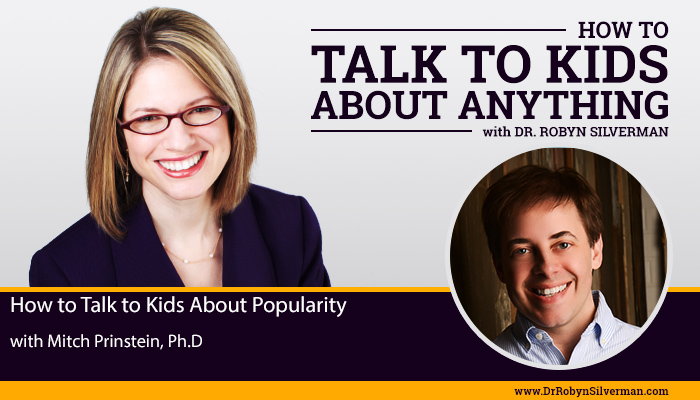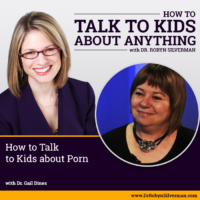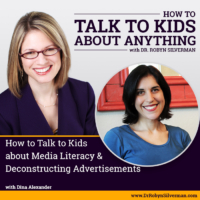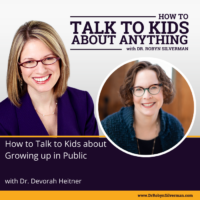Podcast: Play in new window | Download
Subscribe: Apple Podcasts | RSS | More
How to Talk to Kids About Popularity
This podcast talks about popularity—both the damaging kind that focuses on status and the beneficial kind that focuses on likability. We dissect how different kids—those who are accepted, average, controversial, neglected and rejected—fare in school or among friends now as well as later in life. We also discuss how we can help our kids reframe what’s truly important- moving from a biological predisposition for desiring attention to flipping the lens and finding ways to help others feel more welcomed and valuable. Those kids who are likable do very well in school as well as later in life (while kids who simply chase status or who are revered because of their power and status fare poorly) so this is a series of conversations we must have with our children.
Special guest: Mitch Prinstein, Ph.D
Any mention of the word “popular” and many of us are transported to a time when popularity really seemed to matter. Who 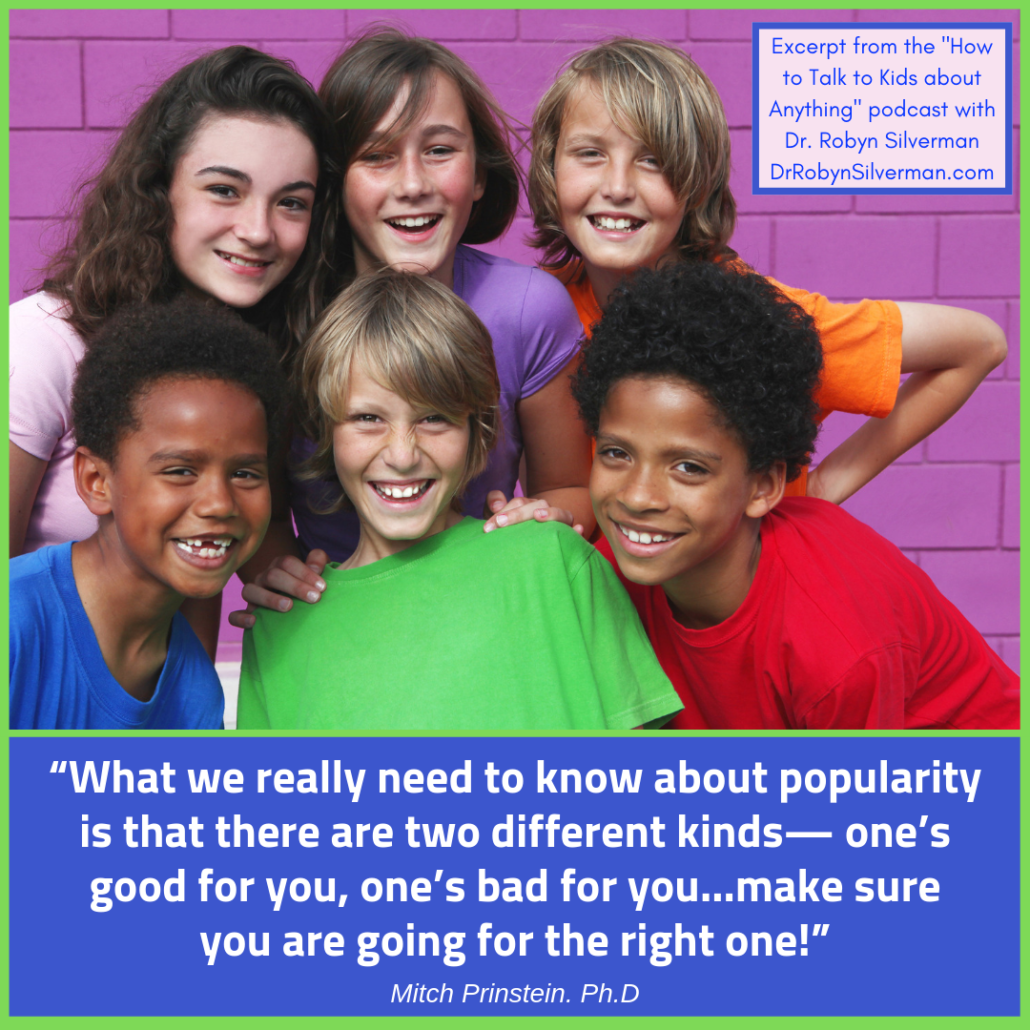 was on top, who was on bottom and who floated somewhere in the middle of the social hierarchy at school and among peer groups? Who was well-liked by many, who was revered by the masses and who was feared by most- you know, the kids who were popular by default because nobody really wanted to attempt to take on the views and power of that group of kids? Interestingly, popularity in our younger years, according to research, can predict how successful we are in our adulthood—but are we, as parents, supposed to help our children to become more popular, then? Actually, the definition of popularity needs to be fully understood to learn the answer to that- and the strategies and key conversations to help our children will follow. For that, we turn to our guest, Dr. Mitch Prinstein.
was on top, who was on bottom and who floated somewhere in the middle of the social hierarchy at school and among peer groups? Who was well-liked by many, who was revered by the masses and who was feared by most- you know, the kids who were popular by default because nobody really wanted to attempt to take on the views and power of that group of kids? Interestingly, popularity in our younger years, according to research, can predict how successful we are in our adulthood—but are we, as parents, supposed to help our children to become more popular, then? Actually, the definition of popularity needs to be fully understood to learn the answer to that- and the strategies and key conversations to help our children will follow. For that, we turn to our guest, Dr. Mitch Prinstein.
Mitch Prinstein, Ph.D. is a husband, a father, board certified in clinical child and adolescent psychology, and serves as the John Van Seters Distinguished Professor of Psychology and Neuroscience, and the Director of Clinical Psychology at the University of North Carolina at Chapel Hill. Mitch’s Peer Relations Lab has been conducting research on popularity and peer relations for almost 20 years—and has produced over 100 scientific works, including a slew of scientific journal articles, book chapters, a set of encyclopedias on adolescent development, and even a textbook on the field of clinical psychology. Mitch is deeply committed to science and training in clinical psychology and his research have been featured in The New York Times, The Wall Street Journal, National Public Radio, the Los Angeles Times, CNN, U.S. News & World Report, Time magazine, New York magazine, Newsweek, Reuters, Family Circle, Real Simple, and elsewhere. He is also the author of the book; Popular: The Power of Likability in a Status-Obsessed World
The podcast provides:
- The key definitions of the 2 different kinds of popularity
- How rejected, neglected, accepted, controversial, or average kids do in school as well as later on in life
- What we should help our kids understand is important to do to stay out of the group that is “unlikable” or rejected—and how to help those who are neglected for the wrong reasons.
- How social media plays a role in our understanding of popularity and values
- How popularity shapes our concept of values and how we can reframe this for our children
- What we really need to know about popularity
- Top tips about popularity, status and likability
Important Messages:
- One form of popularity is all about status: The word popularity takes us back to high school when we often think of the
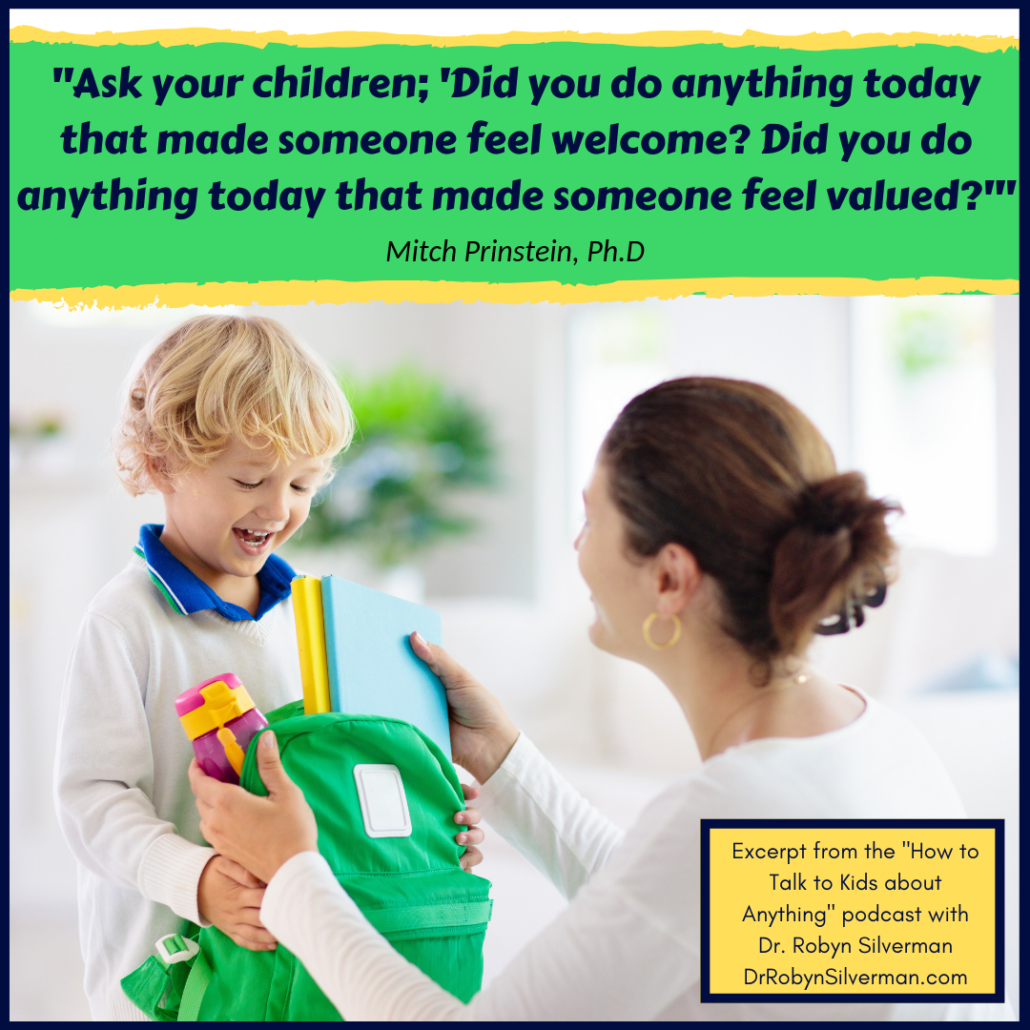 kids who were highest in status- perhaps those who were a bit aggressive, visible, influential.
kids who were highest in status- perhaps those who were a bit aggressive, visible, influential. - Another form of popularity is likeability. The extent to which kids make others feel happy, valued, included—and people want to spend time with these people. Trust them. Want to be lead by them. Want to be friends with them. These two different kinds of popularity play out very differently decades later.
- When you ask kids who are liked the most and liked the least- get reliable results. 50-60% are average. Then there are those who are accepted, neglected, rejected, controversial.
- Neglected- by choice or because we are highly anxious? Some neglected kids do well. Can be skilled in being quiet, listening, respecting group norm. Help guide. When they grow up, can be adaptable. Can work on team’s well. Subset- not neglected by choice, want to have peer interactions- have distress. Stomach aches, headaches. Can feel lonely. Concern for those kids. Which version of neglected are your kids? Are they not “high need for interaction” kids and prefer solo activities like drawing or reading- or might want more interactions but are nervous or anxious.
- Rejected: 50% of rejected kids- are acting aggressively. Interpret an accidental bump as a purposeful intention to harm. Might have learned that in other situation. Reactive. Seeing world through aggressive colored glasses. The other half of aggressive kids might be appropriate—but they have one or two things that they do that cause a problem. Most commonly, they have problems reading the group. We don’t need to conform but there are group norms- how loud we talk, how long we talk, how close we stand, what others prefer. How to join the group—and move the group in a certain direction from within—not stand out and be disruptive of the social norms. How do the other people in the group prefer to be treated?
- Teachers have a great lens to be able to see what’s going on in class with rejected and neglected kids- so we need to talk with them.
- Can you observe your child? Helpful. Parents might have a blind spot- might find it adorable or reminds them of someone else.
- Establish one supportive friendship with at least one child to re-socialize the child into the group- that is associated with more positivity—and less with something that will alienate that child once again.
- Needed: Positive reinforcement and practice. Desire to get positive reinforcement that comes with emotional attention- doesn’t matter if it’s positive or negative- kids will respond to attention even if it’s negative. May have a hard time distinguishing between positive attention which feels good and resulting ostracism that feels bad. Shape children’s behavior by “overboarding” them with positive attention when they do anything positive in a group. A comment- recognizing others, makes others feel valued, give examples “you are going to get much more positive attention when you do those positive, empathetic behaviors and we are going to start to walk away when you are engaging in behaviors that are more annoying- we want to extinguish that as they are not the behaviors you should be relying on.”
- There’s something that happens a year or two before puberty- before physical- brain changes- kids start to crave status. Sometimes become aggressive. Put down then they feel up. Biological reinforcement- oxytocin. “While might feel good now- how is that antithetical to the way we have learned to treat others?”
- We want to make sure that we talk to kids about how although their bodies seem to crave this kind of attention that comes from popularity (status), this is not the kind of attention we want to learn how to illicit.
- See Michele Borba- flip the lens. Unselfie. Empathy.
- Ask: “Did you do anything today that made someone feel welcome? Did you do anything today that made someone feel valued?”
- Focus and give attention to when our children help others feel valued or welcomed rather than when they get the most invitations and have the most status.
- Social media- likes- communicates values.
- Social media reflects a broader problem of our concern for status these days. Addictive mechanism that make us mouse click for likes. Let kids know—it’s okay but in moderation. We can teach safe ways to engage online. What they see online is fake often- and we need to make sure they know! How do they respond to different things online? Allow them to practice.
- Kids are getting more likes than ever before—but they are also more lonely than ever before.
- There used to be a world before all these online interactions—and they should visit it sometimes!
Notable Quotables:
- “How kids were rated- accepted, neglected, rejected, controversial or average- were one of the stronger predictors of many outcomes. Our physical health, mental health, occupational success, our salaries, even the health and wellbeing of our children can all be traced back to what it was like when we were growing up if we don’t start talking about it and addressing who we were. When we talk about it, we can stop the cycle of the issues past down from generation to generation.”
- “I worry about rejected kids. Of rejected kids, about 50% act aggressively. They are highly reactive and aggressive to
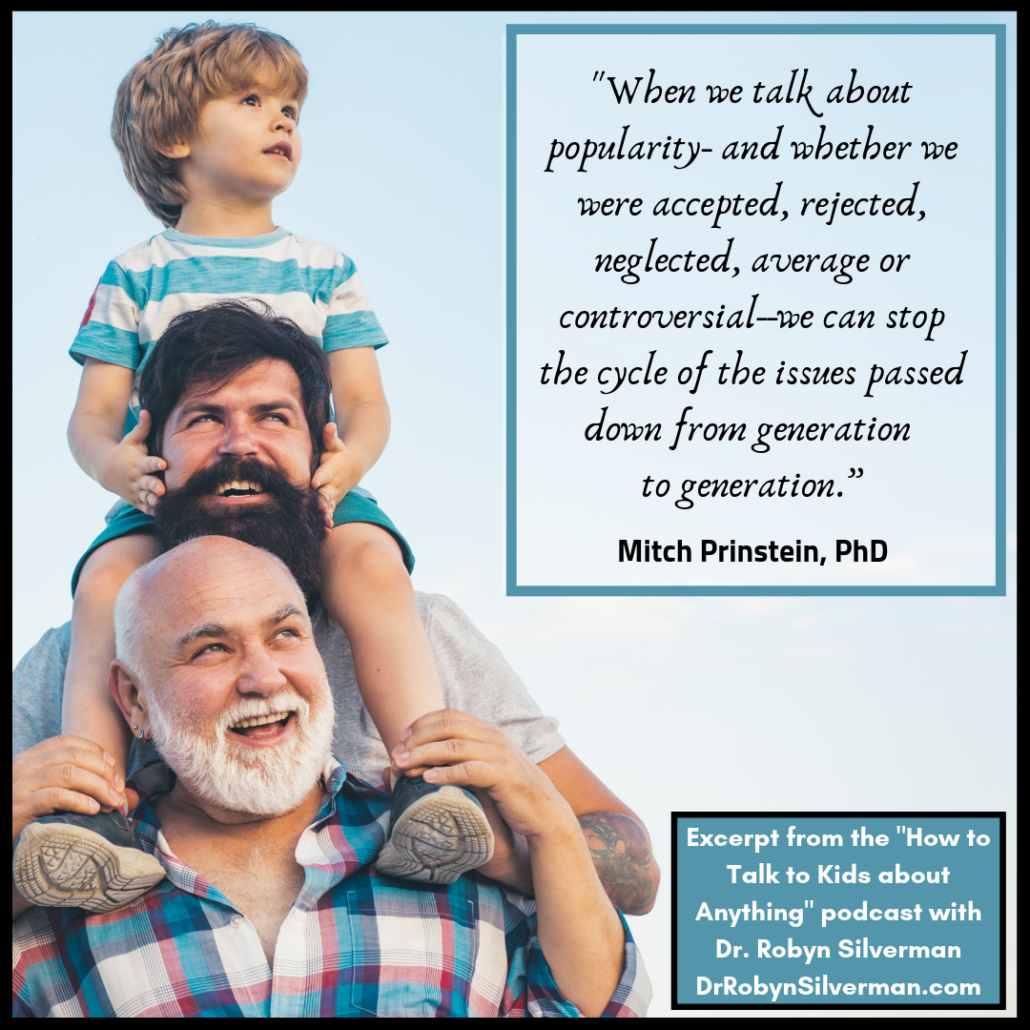 something not going their way. That’s where the work needs to start– is to try and help those kids understand how sometimes they might be seeing the world through aggression-colored glasses when they don’t need to and there might be other ways to respond when they do feel angry and really helping kids to develop non-aggressive strategies.”
something not going their way. That’s where the work needs to start– is to try and help those kids understand how sometimes they might be seeing the world through aggression-colored glasses when they don’t need to and there might be other ways to respond when they do feel angry and really helping kids to develop non-aggressive strategies.” - “It’s really important to talk to kids and help kids who are experiencing rejection We must talk to kids who are being rejected because it is remarkable predictive of difficulties in the future but mostly because it seems to mean that these kids are being denied opportunities to learn things with peers that everyone else is learning as a normal course of their daily routine.”
- “Teachers have a great lens on understanding how it is that other kids are interacting with potentially rejected children, how others are responding to them, and will often have really good clues as to what these children might be doing that might be alienating others.”
- To help rejected children, establishing supportive relationships with at least one child can re-socialize the child back into the group. Close relationships are key.
- “Kids are going to be biologically reinforced with dopamine. It might feel really good when everyone is paying attention to them and they feel really popular. But parents and teachers need to teach kids that while that might feel okay right now, how is that antithetical to the way we have learned to treat other people? We need to focus on the things that we think are going to help us 30 years down the road- the things that are going to allow us to make other people feel good about themselves instead of giving us a momentary high because we felt popular or dominant in that moment.”
- Ask your children; “Did you do anything today that made someone feel welcome? Did you do anything today that made someone feel valued?”
- “Even as we, as adults, pick up our phones and get excited about what texts or tweets we are getting, it may accidentally communicate values to our kids about what we think is important. We have to remember that kids are watching and listening and we have the opportunity to help them develop the kind of popularity that will help them in the long run not the kind that is bad for you 20 years from now.”
- “Too often kids use their offline experience just as fodder to get more likes! We need to remind kids that there used to be a world where we didn’t have any of these online experiences and they should visit it every once in a while to engage in real old fashioned interactions.”
- “What we really need to know about popularity is that there are two different kinds—one’s good for you, one’s bad for you…make sure you are going for the right one!”
- “Talk to your kids about popularity and make sure they know that you know it’s not just an adolescent fad—it’s a really important topic for your kids now and for all of their lives so let’s talk about it seriously.”

